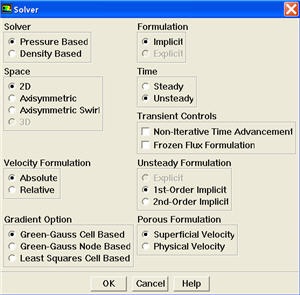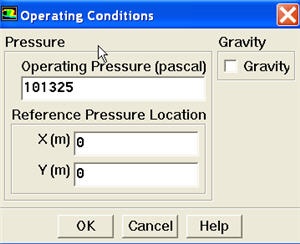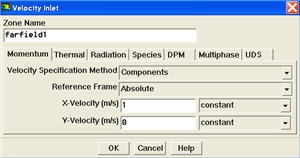| Panel |
|---|
Author: Rajesh Bhaskaran & Yong Sheng Khoo, Cornell University Problem Specification |
Step 4: Set Up Problem in FLUENT
...
Lab Apps > FLUENT 6.3.26
Select 2ddp from the list of options and click Run.
| Panel |
|---|
The "2ddp" option is used to select the 2-dimensional, double-precision solver. In the double-precision solver, each floating point number is represented using 64 bits in contrast to the single-precision solver which uses 32 bits. The extra bits increase not only the precision but also the range of magnitudes that can be represented. The downside of using double precision is that it requires more memory. |
...
Also, take a look under zones. We can see the five zones farfield1, farfield2, farfield3,farfield4, and cylinder that we defined in GAMBIT.
...
Make sure all 6 items under Surfaces is selected. Then click Display. The graphics window opens and the grid is displayed in it. You can now click Close in the Grid Display menu to get back some desktop space. The graphics window will remain.
| Info | ||
|---|---|---|
| ||
Translation: The grid can be translated in any direction by holding down the Left Mouse Button and then moving the mouse in the desired direction. |
Use these operations to zoom into the grid to obtain the view shown below.
...
| Tip | ||
|---|---|---|
| ||
To get white background go to: |
You can also look at specific parts of the grid by choosing the boundaries you wish to view under Surfaces (click to select and click again to deselect a specific boundary). Click Display again when you have selected your boundaries.
...
Main Menu > Define > Models > Solver
Under Time, select Unsteady. We will use the default 1st-Order ImplicitUnsteady Formulation for for now. Click OKUse the default setting. Click Cancel.
Main Menu > Define > Models > Viscous
Laminar flow is the default. So we don't need to change anything in this menu. Click Cancel.
Main Menu > Define > Models > Energy
For incompressible flow, the energy equation is decoupled from the continuity and momentum equations. We need to solve the energy equation only if we are interested in determining the temperature distribution. We will not deal with temperature in this example. So leave the Energy Equation unselected and click Cancel to exit the menu.
Define Material Properties
Main Menu > Define > Materials...
Change Density to 1.0 75 and Viscosity to 0.1. These are the values that we specified under Problem Specification.
Click Change/Create. Close the window.
Define Operating Conditions
...
For all flows, FLUENT uses gauge pressure internally. Any time an absolute pressure is needed, it is generated by adding the operating pressure to the gauge pressure. We'll use the default value of 1 atm (101,325 Pa) as the Operating Pressure.
Click Cancel to leave the default in place.
...
Main Menu > Define > Boundary Conditions...
Select farfield1 under Zone. Change the Type of boundary as velocity-inlet. A new window will pop up. Change Magnitude, Normal to Boundary to Components under Velocity Specification Method. Input value 1 next to X-Velocity. Click OK. Do the same for farfield2 and farfield3.
The (absolute) pressure at the farfield downstream is 1 atm. Since the operating pressure is set to 1 atm, the outlet gauge pressure = outlet absolute pressure - operating pressure = 0. Choose farfield4 under Zone. The Type of this boundary is pressure-outlet. Click on Set.... The default value of the Gauge Pressure is 0. Click Cancel to leave the default in place.
Lastly, click on cylinder under Zones and make sure Type is set as wall.
Click Close to close the Boundary Conditions menu.
...
 Sign-up for free online course on ANSYS simulations!
Sign-up for free online course on ANSYS simulations!


